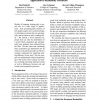Free Online Productivity Tools
i2Speak
i2Symbol
i2OCR
iTex2Img
iWeb2Print
iWeb2Shot
i2Type
iPdf2Split
iPdf2Merge
i2Bopomofo
i2Arabic
i2Style
i2Image
i2PDF
iLatex2Rtf
Sci2ools
EMNLP
2009
2009
Statistical Estimation of Word Acquisition with Application to Readability Prediction
Models of language learning play a central role in a wide range of applications: from psycholinguistic theories of how people acquire new word knowledge, to information systems that can automatically match content to users' reading ability. We present a novel statistical approach that can infer the distribution of a word's likely acquisition age automatically from authentic texts collected from the Web. We then show that combining these acquisition age distributions for all words in a document provides an effective semantic component for predicting reading difficulty of new texts. We also compare our automatically inferred acquisition ages with norms from existing oral studies, revealing interesting historical trends as well as differences between oral and written word acquisition processes.
Acquisition Age Distributions | Acquisition Ages | EMNLP 2009 | Inferred Acquisition Ages | Natural Language Processing |
| Added | 17 Feb 2011 |
| Updated | 17 Feb 2011 |
| Type | Journal |
| Year | 2009 |
| Where | EMNLP |
| Authors | Paul Kidwell, Guy Lebanon, Kevyn Collins-Thompson |
Comments (0)

